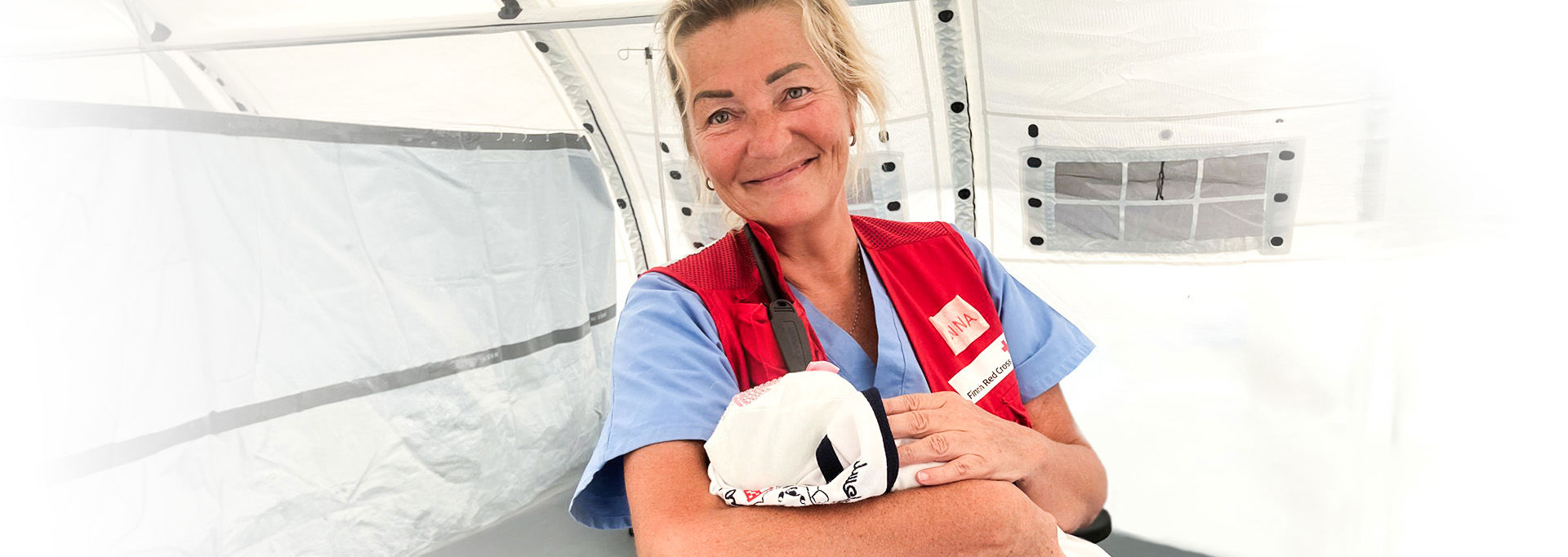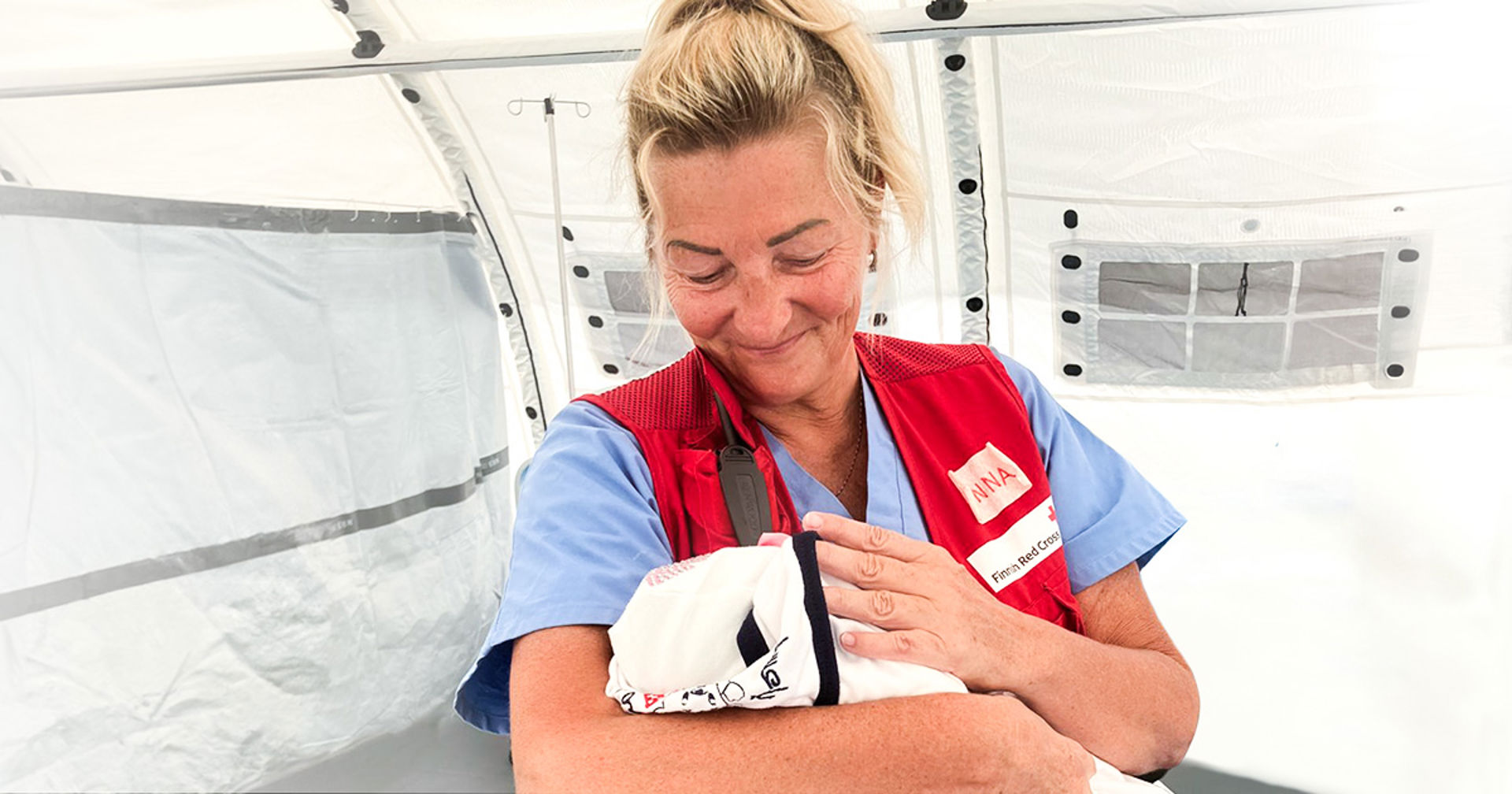
Hunger Day: Your donation helps in times of crisis
Right now, help is needed in places Gaza and in the earthquake-affected area of Afghanistan. In Finland, we assist those facing sudden crises on average three times a week.
Make a Hunger Day donation – it means vital aid for those who need it the most.
Around the world: Emergency aid for crisis areas
By donating to the Disaster Relief Fund, you help those affected by conflicts, natural disasters, and other crises around the world. With your support, we deliver aid to those in need:
- We provide essential supplies such as food, water, shelter, cash assistance, and medicine,
- We take care of the sick and injured,
- We offer mental support,
- We help communities prepare for future disasters and the impact of climate change.

In Finland: Help for those affected by a sudden accident or crisis
With your donation, help is close when a crisis strikes. Our volunteers support authorities in emergency situations and provide mental support to those affected.
With your support, for example:
- We offer mental support to people shocked by sudden situations - we are present, listen, provide hope, and contact loved ones,
- We search for missing people,
- We provide material assistance, such as to those who have lost their homes in a fire,
- We maintain readiness to respond to crises in Finland.
Even a small donation can make a huge difference
€5: A blanket that brings warmth and protection to the person who has faced a disaster
€9: A food package for one week for an entire family in the disaster area
€10: Antibiotic courses for 10 children to a disaster area
€15: Clean water for a child for a year in the disaster area
€50: Emotional support in a crisis - volunteer training in Finland
€180: Clothes for a person who has lost their home in a fire in Finland
This is how the Disaster Relief Fund helps
Approximately 90% of the donations to the Disaster Relief Fund come from private donors. Your support is essential!
In addition to donors, the aid projects of the Finnish Red Cross are funded by e.g the Ministry for Foreign Affairs of Finland and the European Commission’s Humanitarian Aid and Civil Protection department (ECHO). Since all projects require a funding share from the Disaster Relief Fund, aid work would not be possible without our donors.
We warmly thank you for your help!
The Disaster Relief Fund is not committed to any specific target, meaning that funds can be directed to crisis areas with short notice. When a hurricane wreaks havoc, a drought destroys all chances for normal life or life at a refugee camp becomes unbearable, donations save lives.
Emergency aid means taking care of the basic necessities: clean water, food, soap, blankets, tarpaulins and health care for people who have lost everything. We can also send a field hospital or equipment and support for building IT connections in a crisis area. We deliver aid in cooperation with the local Red Cross or Red Crescent society.
The Disaster Relief Fund also supports development cooperation. We help the community affected by a crisis get back on its feet, prepare for any new crises and deal with them as efficiently as possible.
The need for help can surprise any of us at any time. The Disaster Relief Fund also allows us to help people with emergencies in Finland. For example, people who have lost their homes in fires can receive emergency aid, such as emergency accommodation, clothes and hygiene supplies and psychosocial support.
Donations made for the Disaster Relief Fund ensure that trained volunteers are always ready to provide aid across Finland in sudden accidents and exceptional circumstances. During the coronavirus epidemic, volunteers have helped vulnerable people by distributing food aid and running errands for people in high-risk groups.
The fund also supports the Voluntary Rescue Service that helps the authorities e.g. in finding missing persons.
Even a small donation can make a huge difference
€5: A blanket that brings warmth and protection to the person who has faced a disaster
€9: A food package for one week for an entire family in the disaster area
€10: Antibiotic courses for 10 children to a disaster area
€15: Clean water for a child for a year in the disaster area
€50: Emotional support in a crisis - volunteer training in Finland
€180: Clothes for a person who has lost their home in a fire in Finland
The collection expenses of the Disaster Relief Fund must not exceed 20 per cent. This means that at least 80% of the donations are used for aid work.
The amount of collection expenses is monitored by the board and council of the Finnish Red Cross. Collection expenses are expenses caused from acquiring the donations, such as fundraising personnel expenses, the printing and mailing costs of donation request letters, acquisition costs of the collection equipment, marketing costs, and fees collected by external service providers, including operators and banks.
The rules of the Disaster Relief Fund and its monitoring regulate the use of the donated funds.
In addition to life-saving aid supplies and their delivery costs, the Disaster Relief Fund can cover the salary costs of Finnish Red Cross aid workers operating in disaster and crisis areas. Such helpers include doctors, nurses and logisticians working in the areas. The Finnish Red Cross does not carry out international aid operations from Finland using volunteers.
In the target countries, the share of aid workers and local volunteers depends on the situation and task at hand. For example, a field hospital clinic has a 50/50 share between hired employees and volunteers, whereas aid distribution can have one employee responsible for organising the work per 50 volunteers responsible for distribution.
Of the permanent staff of the Finnish Red Cross, only employees working on fundraising are paid from the Disaster Relief Fund collection profits. The salaries of other staff in Finland are funded from several sources, such as the sales profits of Finnish Red Cross products, membership fees, and funding from various ministries and STEA.
In Finland, Red Cross employees support volunteers in their tasks. The aid work itself is carried out by volunteers, apart from a couple of exceptions. These include tasks in crisis situations that require trained psychologists.
Red Cross and Red Crescent volunteers around the world take part voluntarily, out of a desire to help.
The rules of the Disaster Relief Fund and the strict control regulate the use of the donated funds. The accounting of the Finnish Red Cross is audited project-specifically every year, and an annual audit is required from other national associations of the Red Cross. Risk management is essential, because the international Red Cross movement operates in almost all countries in the world, and every country has its own operating culture.
We also analyse our cooperation partners, evaluate their capacity to monitor misconducts, and carry out monitoring ourselves. If the operations do not meet our expectations, we train our cooperation partner to develop their operations. If that does not help, we will withdraw our cooperation. This, also, is development cooperation by the Red Cross.
The Finnish Red Cross has permanent representatives at some aid targets, others we check once a year or more frequently as necessary.
If the target has an external funder, their representatives will visit the aid target to check that reports are accurate and money is spent as agreed.
We also strictly make sure that aid supplies go to those in the greatest need.

